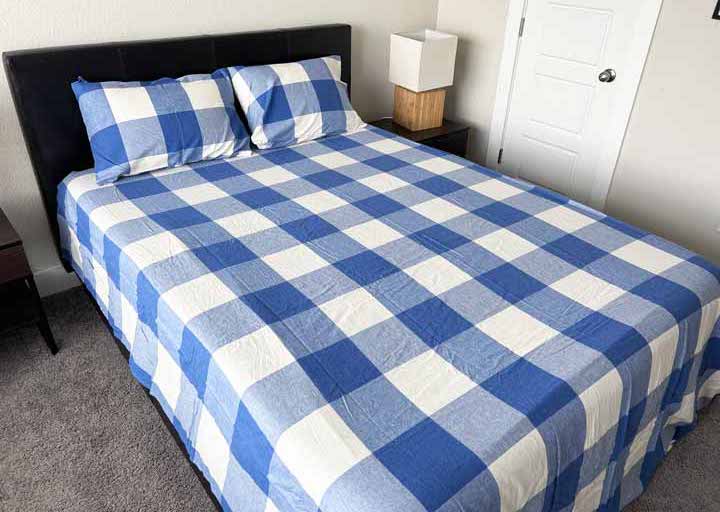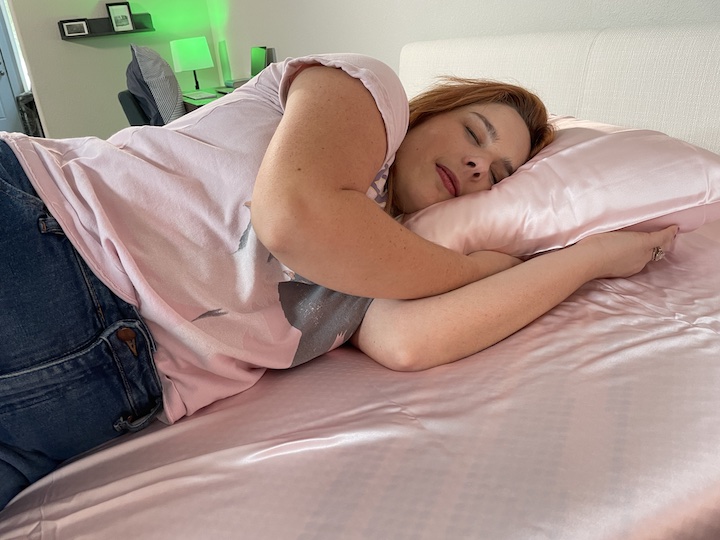If you’re shopping for a new set of sheets, you have a lot of options to consider. You may want a crisp and classic cotton percale sheet, a breathable and eco-friendly bamboo sheet or a cozy flannel set to keep you warm.
If wondering how to buy sheets is leaving you overwhelmed, we’ve got some clarity to help you make the best decision. Beyond material, the next variable most people consider when shopping for sheets is thread count. This guide will help you understand which thread count is best, and whether a higher thread count means one sheet is better than another.
What Does Thread Count Mean?
Many people think that thread count is a measure of sheet quality, mistakenly believing a higher thread count means a better quality sheet.
Contrary to popular belief, thread count is not a measure of quality. Thread count refers to the number of horizontal and vertical threads woven together in a square inch of fabric. In simpler terms, it’s the “thread density” of your sheets. The higher the thread count, the tighter the weave. While some sheets with higher thread counts may be softer and more luxurious, other factors like fabric material and weave style play a crucial role in determining the quality of your sheets.
How Do You Calculate Thread Count?
Fabric is woven like a grid. The horizontal threads are known as the weft, and the vertical threads are called the warp.
Bedding manufacturers use a straightforward formula to calculate thread count. They look at one square inch of the fabric and add the warp (number of vertical threads) to the weft (number of horizontal threads) to get a total thread count number.
Warp + weft = thread count.
If a one-inch square of fabric contains 200 horizontal threads and 200 vertical threads, the thread count of that fabric is 400.
What is the Best Thread Count for Sheets?
Generally, an acceptable thread count for sheets will range from 200-800. In most cases, 300-500 is the sweet spot for quality and comfort. The best thread counts for sheets is specific to the type of sheets you want on your bed.
The Best Thread Count for Different Types of Sheets
Cotton Sheets: Between 200 and 400
Egyptian Cotton Sheets: Between 400 and 700
Bamboo Sheets: Around 300
Linen Sheets: Between 80 and 130
Percale sheets: Can go as low as 180, but generally 200 to 300 is ideal.
Sateen sheets: Between 300 and 600
Cotton Sheets
Cotton sheets are classic, versatile and one of the few instances where thread count can indicate quality. If you are comparing two 100% cotton sheet sets made from single-ply weave, the higher thread count could indicate finer, smoother yarns were used instead of thicker, coarser strands.
Look for 100% cotton sheets with a thread count between 200 and 400 for the best balance of comfort and durability.
Egyptian Cotton Sheets
Egyptian cotton refers to the origin of the cotton plant used to make the thread. Egyptian cotton plants grow in a unique climate that results in a finer, longer yarn prized for its softness and durability. Because you can fit more fine, durable threads into a square inch, good-quality Egyptian cotton sheets are likely to have a higher thread count than non-Egyptian cotton sheets.
Look for a thread count of 400-700 when shopping for Egyptian cotton sheet sets.
Bamboo Sheets
Bamboo sheets are eco-friendly, hypoallergenic and made from a breathable, lightweight fabric that make them great for hot sleepers. Bamboo threads are very long, especially compared to cotton threads. This length allows more threads to be woven together in a smaller area, resulting in higher thread counts than cotton. Bamboo sheets may feature a twill weave (for a more durable sheet) or a sateen weave (for a silkier-feeling sheet).
Look for a thread count of around 300 when shopping for a bamboo sheet set, and pay attention to the weave, which will have more of an influence on how bamboo sheets look and feel.
Linen Sheets
Linen fibers are naturally thicker than cotton, so thread counts on linen sheet sets are usually low. This also provides the airflow and breathability that linen is prized for. Some manufacturers don’t calculate thread count for linen sheets and will provide you with a weight measurement (such as GSMs, or grams per square meter) instead.
Look for a lower thread count of around 80-150 for linen sheets. The lighter the weight of the linen, the more breathable it will be.
Microfiber Sheets
Microfiber sheets are soft and made to repel moisture for a cool, comfortable sleep experience. Microfiber sheets can come in a percale or a sateen weave.
Like linen, flannel, and silk, microfiber sheets are more often measured by weight than thread count. Look for a GSM of 100 or higher.
Flannel Sheets

Flannel sheets generally use a twill weave (the same weave used in denim), resulting in a sturdy fabric that is also soft; flannel is perfect for a cool winter night. When it comes to flannel, thread count takes a back seat to the weight of the fabric, usually measured in GSM.
Flannel sheets with a GSM of 170 or higher will be heavier and warmer, while GSM below 170 will be more lightweight and all-weather.
Jersey Sheets
Like your favorite T-shirt, jersey sheets are knit, not woven, making thread count irrelevant. Jersey sheets are also measured in GSM.
Want that soft-as-a-T-shirt feel? Look for jersey sheets with a GSM around 150.
Percale Sheets
Percale describes a basketweave pattern and results in the crisp feel you get when you crawl into a hotel bed. Percale sheets are often made from cotton.
If you like crisp and cool sheets, look for a percale sheet set with a thread count between 200 and 300.
Sateen Sheets
Sateen also describes a weave pattern, not a fabric’s material. Most sateen sheets are made from cotton, which gets its luxurious, silky feel and lustrous shine from its signature pattern (one yarn under, three or four over).
Look for sateen sheets in the 300-600 thread count range.
Silk Sheets

Silk fibers are too fine to be measured in thread count. Instead, this luxurious fiber is measured in weight. With silk, the measurement is momme (mm), a Japanese measurement unit.
Good quality silk sheet sets range from 16mm to 30mm, with 19mm to 25mm considered ideal.
Is a Higher Thread Count Better?
Why do so many people associate higher thread count with higher quality sheets? You can thank the marketing departments for this one.
It’s not uncommon for manufacturers of any product to call out a particular product feature on the packaging or in a commercial to try and persuade you their product is better. The next time you’re in a grocery store, look at how many products are promising they are “heart healthy,” “sugar-free,” or “part of a balanced breakfast.” It’s a tactic used by all marketers: call out the features and benefits and hope customers buy. Sheet manufacturers will highlight the thread count of their fabric to persuade you to choose their product over the competitors.
Thread count is a measure of density. The more threads woven tightly together, the less likely you are to have air flow circulating. High thread counts could indicate a sheet that isn’t very breathable. If you sleep hot and want a cooler, more breathable set of sheets, a lower thread count that allows for good airflow may be far more comfortable than a higher one.
Thread count won’t tell you anything about the quality of your sheet thread. You will likely find an abundance of finer, thinner yarns in a high-quality sheet, resulting in a smoother finish and durable sheet. On the other hand, low-quality sheets may be packed with thicker courser yarns, resulting in a rougher feel.
Be wary of overly-high thread counts and anything higher than a 1,000 thread count. Manufacturers may count ply instead of individual threads to overinflate the thread count number. Plying is the process of twisting two (or more) individual strands together to create a single, stronger thread. A 600-thread-count sheet made of two-ply yarn could be advertised as a 1,200-thread-count sheet; counting ply instead of individual strands can make it appear that the sheets have double the thread count.
What Makes High-Quality Sheets?
To become a savvy sheet-shopper, look beyond the thread count. The thickness and quality of the yarn, type of material and weave pattern may have much more to do with the quality of your sheets than the thread count.
Does Thread Count Matter?
Thread count can be a helpful indicator of quality when comparing like items. For example, 200 thread count vs 500 thread count single-ply cotton sheets.
However, thread count shouldn’t be the sole factor in your decision-making process. The material of the sheet and your personal comfort preferences will help you determine the best thread count for your sheets.
Thread count can indicate how densely fibers are woven together, which can be helpful when shopping for sheets. Everyone wants to get the best quality sheets for their money. However, thread count is not always an indication of quality, and when it comes to softness, comfort, breathability and durability, a higher thread count is not always better.
FAQs
What’s the highest thread count for sheets?
Sheets are available with 1,000 thread count and higher. However, thread count is a measure of yarn density, not of quality.
Does a higher thread count make sheets better?
Higher thread counts do not always indicate higher quality, and that number could be deceptively high if the manufacturer is counting ply.
How do I choose the right sheets?
When sheet shopping, consider your sleeping habits, the climate, and any allergies or skin sensitivities you may have. You may prefer a linen sheet during the summer or flannel in the winter, for example.
How do I stop my sheets from pilling?
Always follow the care instructions on your sheets’ label to understand how to wash your sheets to avoid pilling. Sheets made of long-staple fibers, such as Egyptian cotton or bamboo, are less likely to pill.

